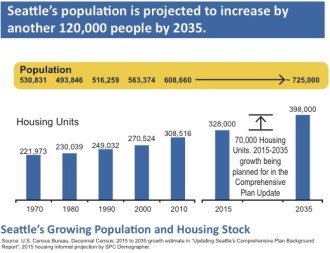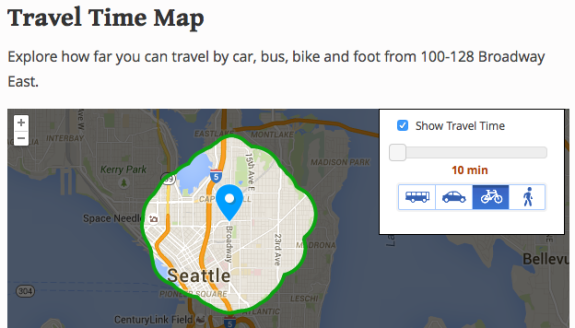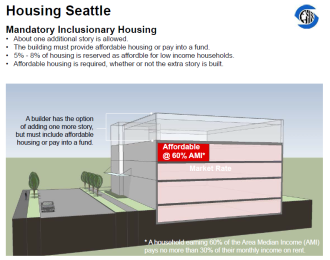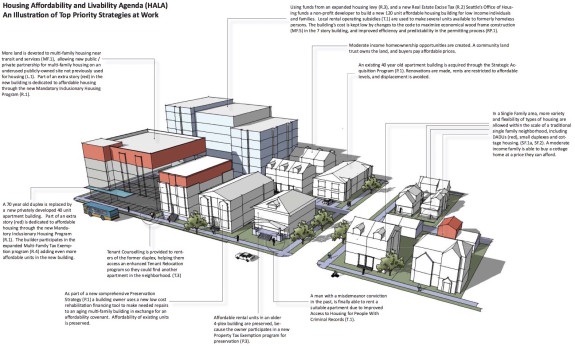
There are basically two ways to increase the number of homes in bikeable and walkable neighborhoods. 1: Improve bikeability and walkability in more neighborhoods, or 2: Increase the number of homes in neighborhoods that are already bikeable and walkable.
Most talk about bike infrastructure focuses on the first way, and of course that’s very important. But the second way is too often overlooked, even though it is just as important.
Housing development as it is today is pretty good at increasing the number of homes in Seattle’s most walkable and bikeable neighborhoods (just look where the cranes are: Ballard, South Lake Union, Capitol Hill, U District, Belltown, etc). But it’s not currently geared to make sure everyone can afford a place in those neighborhoods. And that’s a serious problem.
So if you care about making it easier for more people to make more trips by bike, then you need to get engaged with the Housing Affordability and Livability Agenda (“HALA”) debate.
You can start by attending the city’s Seattle At Work discussion 5 – 7 p.m. tomorrow (Tuesday) at City Hall. For some other ideas, check out Renee Staton’s guest post on Seattle Transit Blog.
Wait! Don’t leave yet! I know HALA debates so far have been confusing and surprisingly heated. But coupled with passage of the Move Seattle levy, the HALA decisions have immense potential to open Seattle’s increasingly bikeable and walkable neighborhoods to more people. And that’s a beautiful vision worth diving head-first into a public debate about.
First of all, if you have only heard angry stuff about HALA, wipe the slate clean and start over. Because there are a ton of really bold and smart ideas in the proposal that have been overshadowed by knee-jerk reactions from some community members and journalists. The proposal is only the stuff that made it through a committee of people who have very different ideas of what should happen, including both affordable housing advocates and for-profit developers.
At the top level, this plan is about how to add 50,000 homes to our growing city in the next decade, 20,000 of which should be designated affordable. People keep moving here, our single-family neighborhoods are out of space to build more houses surrounded by big open yards, and our streets can’t handle more cars.
This is why biking and HALA go hand-in-hand.

More destinations within a ten-minute bike ride of more homes means more people biking. It’s that simple, really. If biking is the easiest way to get there, people will choose to bike. Safe streets and bike routes are one part of this equation, but destinations and homes being closer together is the other part. We need both.
And on the flip side, increasing density relies on more people choosing to walk, bike and take transit. That’s the only way it can work.

Focus recently has been on a so-called HALA “grand bargain” in which developers can build a little higher. They must also reserve 5–8 percent of the units for low-income households (or in some smaller cases pay a fee designated to affordable housing). Developers get the extra height they want, and affordable housing advocates get the “linkage fee” they’re been trying to implement. That’s the bargain.
But there are also a ton of other great ideas in the plan. Like rethinking backwards parking requirement rules that add huge costs to projects (and, therefore, home and retail rents) while also adding to the city’s traffic problems. We have written previously about how parking requirements make housing unaffordable. In fact, Alan Durning, who wrote a fantastic series on the costs of parking requirements a couple years ago for Sightline, is a member of the HALA committee.
Fixing these rules is a really easy and cheap way to make housing more affordable. Here’s how the HALA report puts it (emphasis mine):
Parking quotas are a major driver of the construction cost of new housing, especially of small dwellings in more- urban zones. They can dramatically constrain the supply of new dwellings built, because off-street parking requirements consume large shares of building lots. Off-street parking requirements or quotas have a large impact on the financial viability of new housing for both market and affordable housing development. Parking quotas act as density limits, inflate the average size and price of housing units, and prevent some smaller properties from being developed altogether. The City should review parking policies and requirements to make sure they support housing affordability.
A smarter parking policy coupled with Move Seattle’s investments in transit, biking and walking will work hand-in-hand to address two problems at once: Affordable housing and traffic congestion. This is true for dense urban villages and for single family neighborhoods.
Car ownership levels in Seattle correlate with income. Building parking is really expensive, decreases the number of homes and retail spaces, and adds costs to everyone’s rent whether they drive or not. If we are going to subsidize something, it should be homes, not car parking.
Any time you suggest ideas like this, people get worried about finding an on-street parking space near their homes. But affordable housing is simply more important than easy access to an on-street parking space. And when coupled with bold investments to make it easier to take transit, bike and walk, more people won’t need to have a car parked on the street at all. That’s really the best way to free up parking spaces for those who do own cars.
If there’s a parking problem in your neighborhood, the problem isn’t too many neighbors, it’s too many cars.
These parking rules were put in place long before ever-expanding car sharing services or Link Light Rail or protected bike lanes or neighborhood greenways. Our city keeps changing, and yesterday’s thoughts on the need for off-street private car parking can’t hold us back from building an inclusive Seattle tomorrow.

Other proposals include making it easier to build backyard cottages, duplexes and other higher-density options that fit well in single-family zones. This seems to scare a lot of people, but it’s really not a scary idea at all (UPDATE: A previously version of this story called this “Mandatory Inclusionary Zoning, but it has been brought to my attention I misunderstood that term. Thanks Rob!). It just frees up options for building more kinds of homes in neighborhoods where there is no more space to build despite increasing demand.
A big reason so many newer townhouses are so ugly is that they are effectively homes on stilts in a swamp of legally-mandated car driveways and garages. We can change the rules to make it easier to build row houses, duplexes, townhouses, apartment buildings and other middle-density options that, done right, could be more affordable and more attractive additions to our residential streets.
Essentially nobody is completely happy with every piece of HALA. For example, I attended a debate over rent control during the summer that was packed with people demanding stronger tenant protections to prevent, for example, rampant rent hike evictions happening to people all over the city. A big enough rent hike is essentially an eviction without cause. And once you’re priced out of your place, odds are low you will be able to find anything in the same area on your budget.
Rent evictions are an injustice that too many affordable housing activists are too eager to ignore or write off as a simple problem of supply-and-demand. Build more housing, they say, and people won’t get priced out. But if you are one of the growing number of Seattle renters biting your nails each month dreading the next rent hike that finally kicks you out of your home (or worse, a person who has already been priced out), someone pointing to the invisible hand of the market isn’t very helpful.
On the other hand, increasing supply is obviously the ultimate solution to affordable housing. If more supply-focused advocates can join with Councilmember Kshama Sawant and other tenants rights advocates on this, they would form an unstoppable political force.
And disagreements between these two camps are so small compared to their collective disagreements with people who have already got their homes and simply don’t want any changes at all. That’s the real hurdle, and it’s going to take an immense push to overcome it.
Move Seattle has set a whole new bar for urban transportation funding in major US cities. Now HALA is the chance for the city to lead on affordable housing. Let’s do it.










Comments
30 responses to “What does HALA have to do with biking? Everything.”
I’m going to challenge your thesis a little bit, Tom. It is certainly true that if you add more housing to already-walkable, bikable neighborhoods, you’ll increase the amount of that kind of housing. No doubt.
Let me triage the city into three kinds of neighborhoods. Those, as you mention, that are already walkable and bikable. Those that have a long way to go. And those that are near the cusp of becoming walkable and bikable.
You can probably see where I’m going with this. If you pick the last group – the “cusp” group – to add housing to, you will double your results.
Here’s what I mean. If you pick an already-walkable neighborhood of, say, 1000 homes and add 1000 homes, you’ve increased the walkable quotient by 1000. If you pick a “cusp” neighborhood of 1000 homes and add 1000 homes, you’ve potentially increased the quotient by 2000. This is base on, of course, that the new housing pushes the neightborhood over the cusp.
So, you see, you not only gain the 1000 new units of housing but you also gain by adding the existing 1000 units of housing.
Sure! I don’t think that challenges my thesis. We need it all.
The unspoken part of your triage — you don’t want to add density in neighborhoods that “have a long way to go”, e.g. they have no sidewalks, or have limited transit access (midday buses only every 30 minutes), or have no retail district to walk to.
Unless you can condition approval of larger-scale developments on developers funding/constructing those sidewalks and other amenities. Assuming housing prices continue to rise, there will come a tipping point where developers will fund those improvements if it allows them to build more density in underbuilt neighborhoods.
I basically agree with your point, Josh. Developments that fill in missing pieces could very well lead to the creation of new Urban Villages and thus warrant higher-density zoning. We’re not at that tipping point yet, and with the proposed upzones and boundary expansions for Urban Villages, we probably won’t get there for a while.
How are they going to get sidewalks or better transit access? The answer is by getting a bit bigger. Sidewalks become a lot more affordable if the cost is spread out to more people. Transit gets better when it travels through more densely populated areas. The HALA changes would enable these by allowing for low rise development in more places (like my neighborhood, which lacks sidewalks, but happens to have decent transit).
Ross, we’re going to get more sidewalks and better transit access by paying for them. They don’t appear magically via upzoning SF neighborhoods. And don’t forget, walkable neighborhoods have to have places to walk to — usually business districts or a major institution.
Time to accept the City is not going to upzone SF neighborhoods with no sidewalks, or with only marginal transit service.
Nice article, Tom. I’ve been meaning to write one (not for SBB) about my failure to get a backyard cottage built due to the city’s crazy DADU requirements.
It’s worth noting the density scale. If a place is *too* dense, it actually trends towards walking being the most convenient option rather than biking. Too many people in the way, or maybe it takes longer to get your bike out of the house and then lock up at your destination. Instead, it may be faster to walk. As you reduce density, biking becomes the fastest option. As you get less and less dense, transit and driving become the fastest choice. Downtowns should really be designed so that they’re actually inconvenient to bike (and drive, obviously) through. Sadly, Seattle’s is not; biking will still be the most convenient way through downtown for a long time.
If a person is choosing not to bike because walking is more convenient, then I think we can call that a great problem to have :-)
Well said.
In 2021, or whenever Northgate Link opens and the tunnel is free of bus delays, light rail will be the most convenient way to travel to and across downtown for a pretty large swath of the city. These days there are two different ways to drive across downtown without hitting a single stoplight, and no way to do it via transit or biking without lots of traffic delays.
This is true, but I still hope we make downtown a great place for biking. Transit is more expensive; not everyone has an unlimited pass.
The DADU requirements are probably the most in need of reform. This is where we really fall short. There is a balance to be struck between those that want to see more liberal laws regarding development and those that are focused on preservation at any cost. Building a backyard cottage or basement apartment strikes that balance really well. It preserves the house, while adding density. It should be encouraged and the original HALA recommendations would help immensely.
But, reforming the DADU requirements don’t actually get you that much housing. I mean, of course we should do it, but we shouldn’t expect nearly as much housing as we can get from allowing extra height, smaller/no setbacks, upzoning SFZ areas, etc.
great post, hope the elected officials don’t get scared by the vocal opponents. really important to show up and make the case for quality urbanism.
Thank you so much for this post. There is still a lot of confusion in this city about the benefits of density. It seems like we keep doing this middle solution that ends up pleasing no one–building enough only for a small % of the people moving here, building town homes instead of condos because of height and parking restrictions and so on. There are still a lot of people that think we are making the same mistakes as SF with all this building when we are actually doing the exact opposite.
Town homes are part of the solution as are condos. Check out http://missingmiddlehousing.com/
What’s really silly is single family homes next to the new Capitol Hill light rail station. Now that’s just nuts.
I should have been more clear. I have absolutely nothing against townhomes and agree they are a part of the solution just not the whole solution. I feel like most people associate density with the modern super expensive town homes in their single family neighborhood. I think there would be much more affordable housing if we built more condos in addition to townhomes.
In a typical 3-story townhome we see a lot, literally one third of your home is for storing a car or two. That’s not only crazy, it’s also really expensive. There’s one townhouse near me where the owner has turned the garage into a living space, which is a cool hack. But there needs to be more options for higher-density and more affordable homes that still fit perfectly well (maybe better) in residential areas.
It is hard to say what people associate density with. My guess is most associate it with a crane — meaning a new big apartment building. But townhomes, condos, and ADUs can all add a lot of density at very little cost. One of the most affordable ways to add housing is to convert a house into an apartment. But our rules make this very difficult in most parts of the city. One of the big steps is to get rid of the parking requirement in all developments. Doing so would make apartments a lot more affordable, but it would also lead to a lot less driving.
The relevant parts of Seattle already don’t have parking requirements. HALA has been watered down in other areas.
What Does HALA Have to Do With Vision Zero?
Vision/Target Zero officials at all levels recognize how challenging it is to achieve their goal (of zero transportation death and serious injury by 2030). There are thousands of professionals from many disciplines all working toward this end, utilizing various strategies and policies, but, arguably, the tool of land use (and density) has been missing from the discussion (that I’ve seen — but please educated me if you think it has been very directly linked by elected or agencies). And we need every tool at hand in this effort, because the _unofficial numbers_ I’ve seen for 2015 indicate a disappointing RISE in the number of traffic deaths for the first time in years. We can and must continue to work to prevent these tragedies from occurring.
So, when HALA advocates are talking to elected officials, the press, or anyone else, for that matter, don’t forget to include that HALA (and like densification policies) will help save lives by: converting car trips into walking and biking trips, and by supporting transit for longer trips (you can be as distracted a transit rider as you want, eating, grooming and using your smartphone, and nobody will die, though you might miss your stop). And that’s just a couple ways land use can help increase transportation safety — there are more.
Holla for HALA!
Great article! Hope a lot of people make it to the meeting. Check out the population projections in your first chart – we’re already more than halfway to meeting the 2035 projection. 725k by 2035 looks awfully conservative now.
Minor nitpick:
Given that Sawant won’t come out and say she supports HALA (at least, she wouldn’t during the election), I’d say there’s more than a minor difference between the sides. I don’t know any density advocates who wouldn’t happily agree to affordable housing set-asides (or impact fees in lieu) in exchange for allowing the market to satisfy people’s actual housing preferences by building a lot denser. Sawant seems to prefer density only if the government builds it (at least, that’s the only sense I can make of her decidedly anti-poor stance on building.)
The problem with increased density isn’t loss of parking, it’s loss of trees. And it’s replacing affordable housing with expensive and inhumane townhouses. I’d happily trade the required parking for required green space. A few really tall buildings and some added green space would be WAY better than the current trend toward replacing trees with townhouses on lots that are 90% paving. More trees and sidewalks. More affordable housing. Less parking. Please.
Amen to the comment about trees and GREENspace. The SDOT project mgr at the Roosevelt open house last night mentioned a 2-for-1 tree replacement requirement. I’ve no idea who that policy covers, but doesn’t seem to cover the new zero-setback townhomes being built on Capitol Hill where trees in the planting zone are felled to make room for driveway cuts for the new residents’ car access. Yes, I’m upset about this. Removing trees radically changes the character of the neighborhood, and for the worse.
That policy covers the public right-of-way (trees along a roadway or sidewalk). Trees on private property are handled by other city departments (I believe it used to be DPD, but that has been split up into two separate departments that I’m less familiar with). Anyone who removes a tree from the space between the sidewalk and roadway is supposed to get a permit from SDOT, and basically isn’t allowed to do it unless they’re replacing the tree or the tree is diseased or hazardous.
http://www.seattle.gov/transportation/treepruning.htm
http://www.seattle.gov/transportation/docs/Street%20Tree%20Manual%20WEB.pdf
The 2-for-1 policy is for all city departments. I have no idea how that affects individuals who remove a tree (with a permit!) with no intention to replace it.
If you notice a tree that’s gone, you can check with the city to get details. Fines start at $500 for damaging a tree, and go up from there..
[…] We wrote earlier this week about HALA and the city’s proposed plan to increase affordable housing. At the far end of that housing spectrum is, of course, homelessness. 3,000 students in Seattle Public Schools are homeless, and four of five of them are children of color. […]
[…] Big issues the Board may (or should) discuss in the next two years: Downtown protected bike lanes, bike connections to and within Rainier Valley, and (I hope!) intersections of biking and affordable housing as part of the city’s HALA debate. […]
Developers don’t need much more incentive to build in neighborhoods than the high real estate price right now which allow them to make oodles of money and the high rents. Both these things refute Alan Durning’s complaint about how parking requirements ruin a developers bottom line. And that leads to the central problem with the entire HALA report. It’s not really about providing affordable housing. It’s about providing a City Development Structure that allows developers to make the most money!
I think you missed the major point of that report. It’s not that developers need more incentive to develop, it’s that mandating parking the way we do adds cost, reduces the number of units constructed per building, and (in a commercial area) reduces the retail space. If you have to pay an exorbitant amount of money to dig three floors of parking underground, then of course you’re going to design luxury apartments and condos. High-end appliances and finishes cost pennies compared to digging a parking garage.
What we need are regular (meaning affordable for working people) apartments and condos, and we need more of them. That’s the only way.
Parking isn’t the only change HALA can make to increase affordable housing, but it’s a big piece.
This isn’t about whether you like or trust developers. I see it as one way to change the way developers are currently supporting wealthy car ownership at the expense of working class homes. Car parking in a dense neighborhood is a luxury. We don’t mandate crystal chandeliers or marble countertops, so why mandate an underground car parking space?